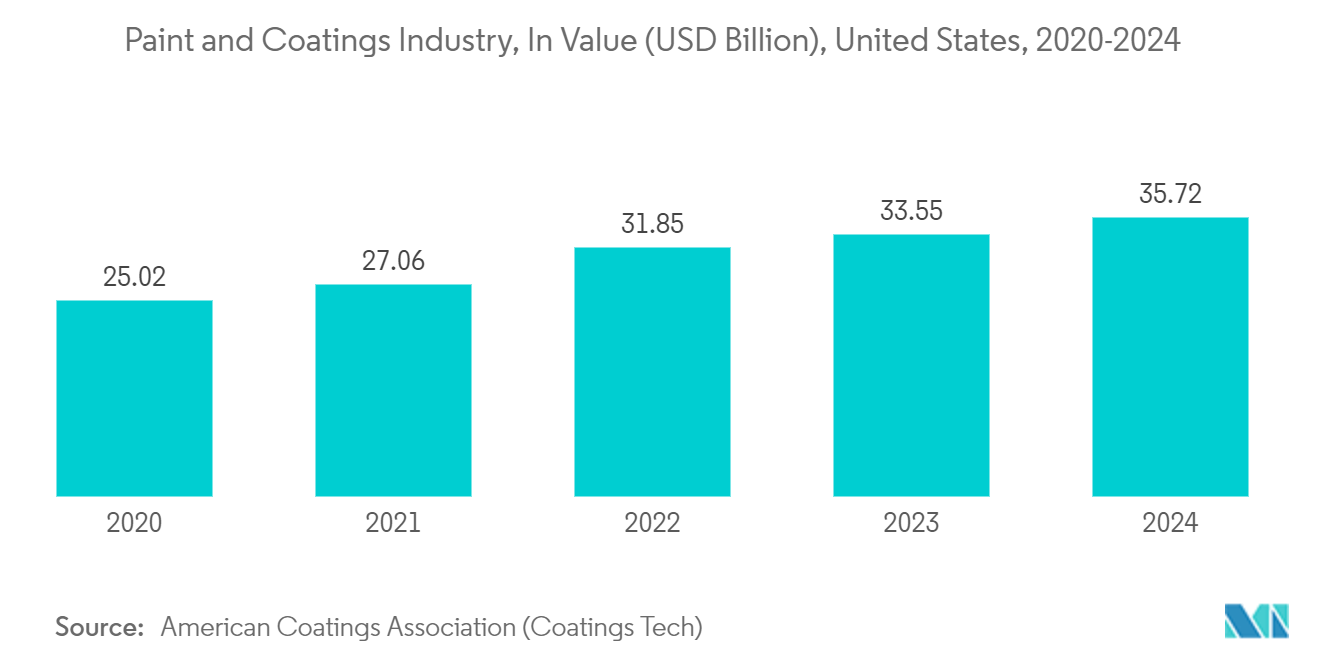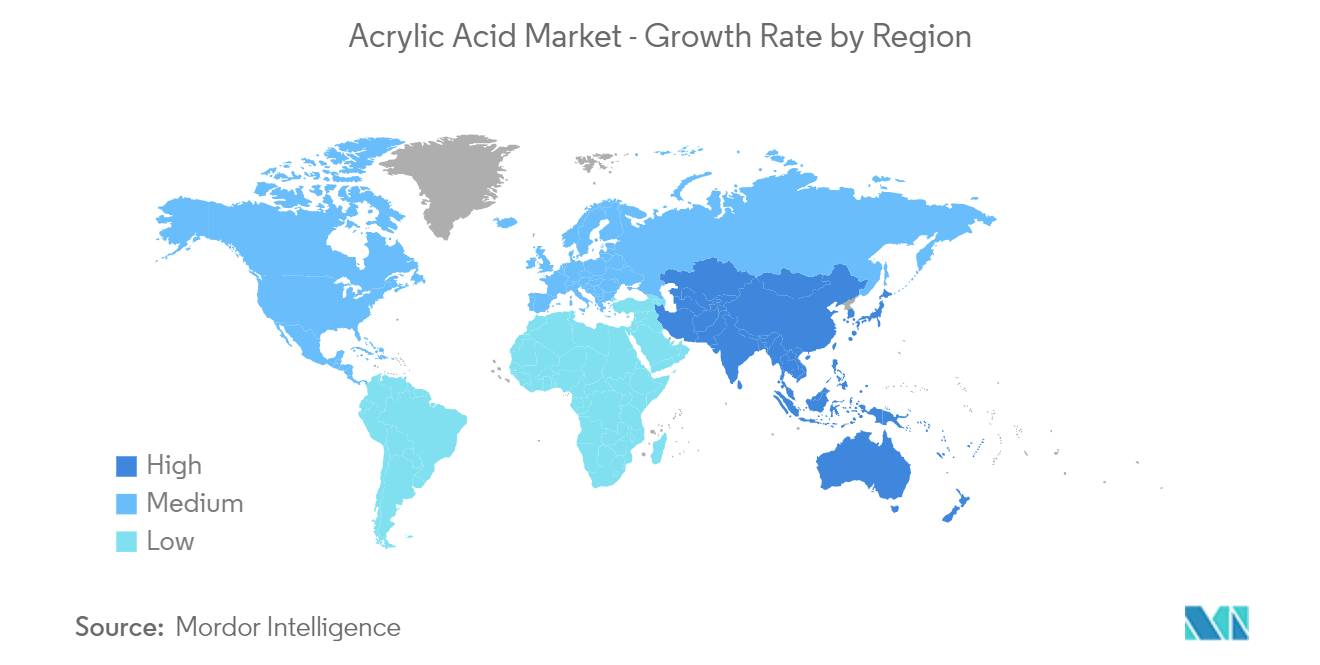Market Trends of Acrylic Acid Industry
The Usage of Acrylic Acid in Paints and Coatings is Increasing
- Acrylic acid is used to make acrylate esters, which are used in various applications, including paints and coatings.
- Acrylics are used in architectural coatings, finishes for products for original equipment manufacturers, including automotive (OEM) and refinishes, and special-purpose coatings.
- Acrylic powder coatings have been introduced as clear coats on car bodies. Although it is an ideal solution for many applications, curing is achieved at a high temperature in an oven. It is, therefore, not universally applicable (e.g., painting of wood and plastics).
- Architectural coatings are meant to protect and decorate surface features and are used to coat buildings and homes. Most are designated for specific uses, such as roof coatings, wall paints, or deck finishes. Each architectural coating must provide certain decorative, durable, and protective functions despite their use.
- Most homeowners prefer the color of their choice for the living room and bedroom walls. Acrylic paints are the preferred choice as they offer a wide variety of choices in terms of color and shade. A vast majority of ceilings are painted flat white so that they may reflect the majority of the ambient light in the room to make the resident feel that the room is spacious and relaxed. Basement masonry walls can often weep water.
- In May 2022, Grasim Industries (Aditya Birla Group) planned to invest INR 10,000 crore (USD 1,209.47 million) in its paint business by FY 2025. In January 2021, the company announced plans to enter the paints business with INR 5,000 crore (USD 604.73 million) in the next three years. The company will likely commission a paint plant with a production capacity of 1,332 million liters per annum (MLPA) by Q4 FY 2024.
- The paints and coatings industry in India serves as a crucial barometer of the country’s various end-user industries, significantly contributing to both technological advancements and macroeconomic expansion. In recent years, this sector has witnessed substantial growth, reflecting broader industry trends.
- According to European Coatings, the Indian paint industry amounted to nearly EUR 9.5 billion in 2023 (USD 10.22 billion), and it is expected to grow by 14% over the coming years. This is expected to increase the demand for special-effect pigments in the country.
- The Indian paint Industry is projected to invest INR 350,000 million (USD 4.19 billion) to INR 450,000 million (USD 5.29 billion) in capital expenditure. Various investments in the Indian paints and coating industry are as follows:
- According to the American Coatings Association, US architectural coatings accounted for 49% of the total market in 2023, while OEM and particular purpose coatings comprised 30% and 21%, respectively. In 2023, the production revenue of the paint and coatings industry in the United States was estimated at approximately 1.31 billion gallons, with forecasts predicting that production will exceed 1.34 billion gallons in 2024.
- Germany stands among the leading producers of paints and coatings in Europe, boasting approximately 300 manufacturers of paints and printing ink, many of which are small- and medium-sized enterprises. With prominent paint manufacturers such as BASF SE, Dow, Beckers Group, Brillux, Altana Chemie, Meffert, and Mankiewicz headquartered in Germany, the demand for the market is expected to escalate in the country.
- In June 2023, Adler, an Austrian paint company, commenced construction on its new service facility in Herford, Germany, with an investment of roughly EUR 10 million (USD 10.86 million). The official opening and inauguration are scheduled for early 2025, with construction set to continue until late summer 2024.
- Overall, the demand for acrylic acid is expected to witness moderate to high growth in the region after the initial recovery period.

The Asia-Pacific Region is Expected to Dominate the Market
- The Asia-Pacific dominated the market due to the high demand from countries like China, India, and Japan.
- China is the largest consumer of acrylic acid in the Asia-Pacific region, and its demand is expected to grow during the forecast period. The demand for adhesives, paints, and coatings in China is also increasing significantly due to the growing investments in the construction and infrastructure sectors.
- China is one of the major consumers of personal hygiene products globally. The country's demand for personal hygiene products is attributed to a large infant population and increasing disposable income, leading to increased spending on personal and hygiene care. Thus, the market for acrylic acid is expected to grow during the forecast period.
- China is known for its industrialization and manufacturing sector, where paints and coatings are widely required. Some of the major sectors where paints and coatings are used in the country are the automotive, industrial, and construction sectors, among others. China accounted for more than one-fourth of the global coatings market. According to the China National Coatings Industry Association, the industry has been registering a growth of 7% in recent years, driving the acrylic acid market in coatings application.
- Nearly 10,000 coatings manufacturers are located in China. Most leading global coating manufacturers, such as Nippon Paint, AkzoNobel, Chugoku Marine Paints, PPG Industries, BASF SE, and Axalta Coatings, have manufacturing bases in China. Paints and coatings companies have been increasingly growing investments in the country. This is likely to fuel the market for acrylic acid used to manufacture automotive paints and coatings.
- The Chinese government rolled out massive construction plans, including making provisions for the movement of 250 million people to its new megacities over the next ten years. Thus, this may create a major scope for acrylic acid in paints and coatings used in various applications during building construction, enhancing the building properties.
- India's construction Industry is projected to reach a value of USD 1.4 trillion by 2025. By 2030, an estimated 600 million people will live in urban centers, resulting in a need for 25 million additional mid and ultra-luxury units. Under the National Investment Plan (NIP), India has an infrastructure investment budget of USD 1.4 trillion, with 24% of the budget earmarked for renewable energy, roads and highways, urban infrastructure, and 12% for railways.
- Hence, due to these factors, the Asia-Pacific region is likely to dominate the acrylic acid market during the forecast period.


